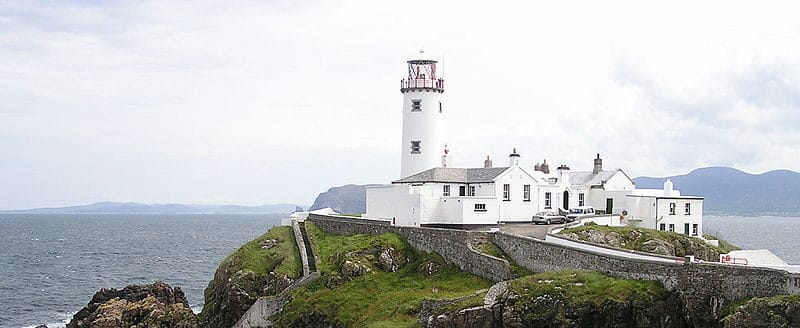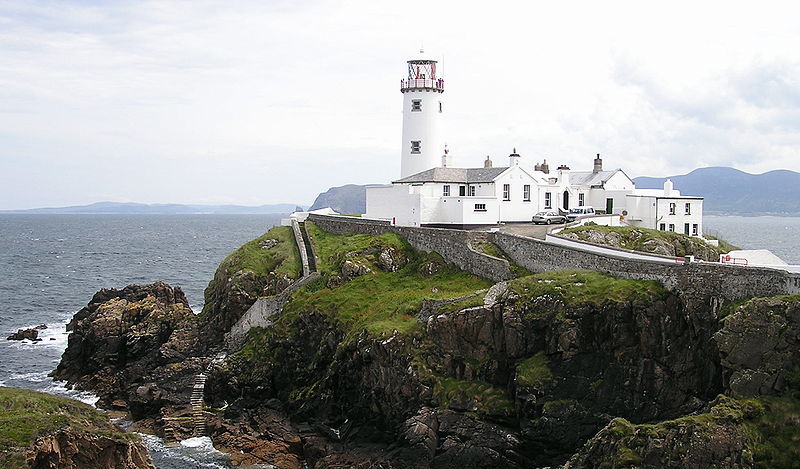Fanad Head Lighthouse: A Spectacular Maritime Icon in Ireland

Updated On: November 07, 2023 by ConnollyCove
Situated between Lough Swilly and sandy bay of Mulroy, on the Northern coast of the Fanad Peninsula in North Donegal Fanad Head lighthouse has stood the test of time, shining its two beacons of coloured lights since St. Patrick’s day in 1817. It’s easy to recognise the main attraction on this peninsula, conceived as essential to seafarers following a tragedy over 200 years ago.

Provenance
The story goes that in 1812 the frigate Saldana was wrecked on “Fannet Point”, as it was called then, and became completely lost to the sea. The only survivor was the ship’s parrot that had a nametag with the ship’s name.
Soon after the loss of this vessel, Captain Hill of the Royal Navy in Derry, whose experience of the north-west coast from Blacksod to Lough Foyle was second to none, wrote to one of the members of the Corporation for Preserving and Improving the Port of Dublin (the Ballast Board, the predecessor to the Commissioners of Irish Lights) suggesting that a lighthouse should be placed on Fannet Point. He also backed up his request by stating that the Saldana would not have been lost if there had been a light on Fannet.
A Remarkable Lighthouse
And since then, Fanad Head lighthouse sits on the western shore of the Peninsula. Unsurprisingly, it was voted one of the most beautiful lighthouses in the world, the second after Lindau Lighthouse in Germany. Indeed, a quick internet search shows that it’s an extremely popular subject for photographers, both from the local area and from further afield. Moreover, the Lighthouse is the second most Northerly lighthouse in the Republic of Ireland.
It was George Halpin, a renowned civil engineer at the time, who designed Fanad Head lighthouse. It was constructed at a cost of £2,000. Its lantern has two lights, one red light that shines out over the sea and two white lights that shine towards the Fanad Peninsula coastline.
Later in the same century it was built in, a larger and higher tower was commissioned. The lamp, too, was upgraded and went into operation in 1886 using paraffin. The staircase within the lighthouse wind 79 steps to the top of the tower. Also the lighthouse stands 39 metres above sea-level.
All-Around Fantastic Views from Fanad Head Lighthouse
The road to Fanad from Rathmullan will take you along one of the most spectacular sections of coastal road in Ireland. The Knockalla drive offers scenic views across Ballymastocker Bay and Portsalon which will leave you breathless. From this vantage point, it’s not difficult to see why the beach was voted as the second most beautiful in the world.
History Marks on Fanad Head Lighthouse
Many historic events involving famous Irishman have taken place in the area of the Fanad Peninsula. The best known is the Flight of the Earls. In September 1607, the two remaining northern Earls of Ireland, along with nearly 100 family and followers, fled the small country to Spain, with no reason or explanation but with haste.
The actions of the two were to become known as The Flight of The Earls and would be one of the most perplexing stories in the history of Ireland’s fight for independence. The Earl of Tyrone, Hugh O’ Neill and the Earl of Tyrconnell, Rory O’Donnell the brother of Red Hugh O’Donnell, were the last two remaining earls that held even the smallest amount of power in the north of Ireland.
Fanad Head Lighthouse was struck by lightning on the night of the 20-21 December 1916. The Principal Keeper reported the incident to the Inspector, Captain Deane. In his report to the Board, submitted extracts from the rules of the Lightning Research Commission of the Royal Institute of British Architects for the erection of lightning conductors as none of the stations were properly protected. He also suggested contacting Trinity House and the Northern Lighthouse Board.
Perhaps one of the most revolutionary changes to occur in the Lighthouse Service happened towards the end of 1969 when helicopters were introduced to effect the reliefs of rock stations from Fastnet in the south-west to Inishtrahull on the north coast. Fanad Head was chosen as the land base for Tory Island and Inishtrahull.
A Maritime Icon in Ireland
Visitors will finally have the opportunity to visit the building, to learn about the science of lighthouses, to hear stories about light-keepers in days gone by, and, not for the fainthearted, to climb to the top of the tower for spectacular views of land and sea.
To add more to your enjoyment, the new visitor centre at the Lighthouse will add to the experience of viewing this beautiful historic site with tours and even self-catering accommodation at the lighthouse is now available.
Other blogs that might interest you:
Castle Coole: A Great Neo-Classical House in Ireland|The Gobbins: Europe’s Most Dramatic Cliff Path|Jeanie Johnston: Irish Emigrant Ship| Best Beaches in Ireland|






